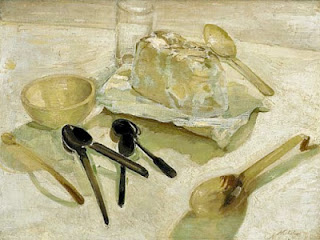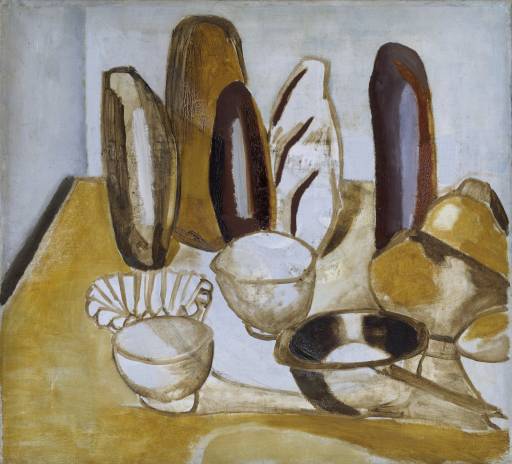As I didn’t have the required coloured AND textured A3 paper for this exercise, I improvised a little with what I already had; I found a large off-cut of cornflower blue card and cut it down to size, before rubbing it over with some wire wool to ‘texturise’ the surface. Et Voila! It seemed to have done the trick…..
Apprehensive would pretty accurately describe how I felt when I came to this exercise. I had rediscovered some oil pastels in my art kit but I must have purchased them – no lie – over 10 years ago, back when I was contemplating art in sixth form. They stayed in my art kit and were never used, and I cant think why. I took a sharp knife to them and sliced off the ends to reveal fresh, buttery colour and hoped that they would work…
The objects I chose were a pineapple (first time ever drawing one), a red pepper, a sliced kiwi and a sliced lemon. Being a bit obsessed with complementary colours, I purposefully chose a red pepper so that it would contrast with the various greens in the pineapple leaves and the flesh of the kiwi. Inspired by the reference photo of another students’ work in the course book, I decided I would place my objects on a plate to create more interest and avoid using my kitchen table as a backdrop AGAIN. I thought the plate would also continue the ‘circular’ theme, i.e. echoing the main shape of the objects placed upon it.
I arranged the pieces on the plate and moved around it, trying to establish some possible compositions. The course book didn’t specify doing preliminary sketches but I decided I like to do this now to prepare for most of my finished drawings so therefore I quickly produced three different scenarios in my sketchbook, using a ballpoint pen.
I settled on composition No. 3, simply because I found the viewpoint the most pleasing; I liked how the curve of the plate just passes out of view and takes up most of the bottom half of the composition. In my final drawing, however, I decided to alter the position of the sliced kiwi, to create more of a negative space between it and the lemon. To begin with, I selected pastels in the colours that were closest to my objects, and roughly drew their outlines. It was at this point that I made a mistake when drawing the decoration on the plate (the inner blue ring, to the left of the kiwi), but I figured that the pastel was thick enough to be able to scratch it back a little. This worked in removing the pastel but some staining was left behind.
Next, I selected the darkest colours and started to roughly block in these areas using a hatching/stippling effect. The pastels resisted a little – I wasn’t sure if this was due to quality or age. I found that the more pressure I applied, the better the result! Except my arm became tired quite quickly…For the blue plate, I did what the course book suggested and overlaid another related colour i.e. purple over blue. I found this gave the shadows a much richer feel and added warmth, as opposed to if I had used black.
For the remainder of the drawing, I didn’t adopt my usual method of working from dark to light, or vice-versa; I simply worked over and over the drawing, building up layers where I saw appropriate, and I found this very liberating. I was amazed at how much I enjoyed the spontaneity of the pastels and how all of the marks I put down seemed to fit perfectly. I saw many colours in the pineapple, for example, such as purple and light blue, but worried that adding these would make it look surreal. I needn’t have worried, as these colours seemed to belong where I put them. The course book mentioned leaving the ‘white’ to show through, despite having had to choose a coloured paper; I assumed that this simply meant let whatever support you had used to break through in places, and I feel I achieved this, not least because this seems to be a natural outcome anyway when using oil pastels.
It occurred to me that it was almost impossible to make a ‘mistake’ as the colours and marks I made harmonized together to create – what I felt – to be my most experimental drawing to date. This was my first drawing using oil pastels, and I was left wondering why I had been so afraid to use them in the first place. I was expecting to take hours on this piece, building up the layers, but instead spent a rather pleasing two hours or so layering on luxurious colour and enjoying every minute of it.

Research Point: Ben Nicholson
I adore having to research an artist I haven’t previously heard of, and Ben Nicholson is no exception. I somehow envisaged a more recent artist, perhaps still alive, but maybe this was due to his rather modern-sounding name.
Ben Nicholson OM – which I discovered stands for Order of Merit (for great achievement in the arts) – was born to two artists, which must have had a great deal to do with his following the same career path. His early paintings were influenced by his father William Nicholson’s work, a master of subtle tones and light.


Comparing Nicholson’s Bread with his fathers’ work A Scottish Still Life, one can see certain similarities, such as the tonal shading inside the bowls. However there is not much else to tie these two works together, as Bread is a more abstracted approach that sees him flattening his objects so that some are almost unrecognisable (the statue-like breads, for example, that seem to be stacked on top of the other objects). His use of colour is also rather harsh in comparison, applying it with thick, bold brushstrokes. This is a rather early work, which sees him moving away from the more regimented, academic practice of painting and taking inspiration from Post-Impressionism and Cubism.
During the 1930’s Nicholson adopted an extremely abstract style, producing a series of relief pieces, mostly in white. When he moved to St Ives in the late 30’s with his second wife, sculptor Barbara Hepworth, he began to work once again on landscapes as his dealers considered these easier to sell and he was able to make something of a living.

St Ives, Cornwall features a Union Jack to celebrate V.E (Victory in Europe) Day on 8th May 1945, which suggests it was a late addition to the painting given the timeframe of its completion. This is a curious piece, with all objects flattened except for maybe the boats in the distance that have a more solid appearance. The cups/mugs on the windowsill appear as though from the pages of a pop-up book, looking fragile and like they could blow over with the slightest gust of air. The elements of the objects all seem to intertwine and become a whole, as opposed to separate pieces. This painting was one of a series, and allowed Nicholson to revisit his experimentations with objects and their positioning in space from the previous decade.

Still Life is an example of extreme abstraction, depicting a completely compressed table with objects that appear enmeshed within it. The colours in his subtle palette, most notably the white and red, were ones he favoured in the early post-war years and were understandably used to distinguish certain objects from the others surrounding it. It has an almost collaged feel, as though each of the elements has been torn or cut from an entirely different piece of paper and stuck back together in a haphazard manner.
The course book asks “Why does he simplify still life forms and negative space and superimpose them on the Cornish landscape?”. There is also a reference picture of Nicholson’s Four Pears that apparently has the suggestion of a landscape behind it; I personally cannot see this, however it may be very subtle.

Perhaps the one painting that illustrates this best to me is Cornish Landscape, where ghostly, transparent objects are suggested through the clever use of line that incorporate themselves into the landscape behind it. My one theory as to why Nicholson began this practice is simply that it was a progression from his earlier works that featured the windowsill and perhaps a tabletop, whereby he completely did away with these ‘barriers’ to merge the elements together into one entity. The result is most certainly experimental but at the same time an acquired taste for those who are used to viewing still life and landscape paintings with clearly defined boundaries, forms and tone.
References
http://www.kettlesyard.cam.ac.uk
Check and Log
Your composition should occupy most of the paper’s surface. How much negative space do you have left?
I think I have done quite well here in striking a pleasing balance between the objects and the space they occupy, and the negative space. Negative space is only visible in the four corners of the drawing.
What have you learned from drawing the details of the fruit and vegetables?
All fruit and vegetables have a distinct, individual texture and it is wise to consider what drawing implement and technique you will use beforehand so that you can represent its appearance in the best possible way. I’ve really enjoyed looking at different kinds of produce, especially the pineapple in my oil pastel piece; I have never before drawn so many fruits in such a short space of time and rather than wanting to move on, I’d quite like to do more.
What did you find most challenging about this part of the course?
Trying to find a composition that wasn’t too similar to one I’d done before; I had to try hard not to put objects in the same place, or the same groupings. I was also conscious that I couldn’t afford to keep replenishing my stock of objects, therefore had to make use of what was in my fridge/fruit bowl at the same. The same red pepper made many appearances!












